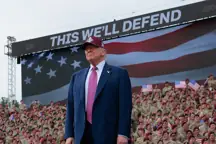If World War III were to kick off, the U.S. Government might look to its citizens to help out, but would you be drafted?
Global tensions seem to be rising, particularly in the Middle East, in Ukraine, and in Russia.

On June 21, Trump confirmed that the U.S. had carried out a significant airstrike on Iran, targeting three major nuclear facilities: Fordow, Natanz, and Isfahan.
This action marked a major development in the ongoing conflict between Israel and Iran, which has sent shockwaves across the Middle East.
This military move is just one part of a growing concern among international experts that the U.S. could be drawn into further global conflict.
A recent survey by the Atlantic Council’s Scowcroft Center for Strategy and Security revealed that 65% and 69% of respondents believed that a direct confrontation with China or Russia, respectively, was increasingly likely in the coming decade.
More than 40% of those surveyed even predicted a world conflict involving multiple great powers, with two-thirds of them expecting nuclear weapons to be deployed, potentially including battles in space.
Should such a global conflict erupt, the United States may be forced to call upon more citizens to serve in its armed forces.
While the U.S. has not had a draft since 1973, all male citizens and immigrants are required to register for the Selective Service once they turn 18, a system that could be activated in the event of a national emergency.
The process for reinstating the draft would involve a series of steps, including a “draft authorization” by Congress and the activation of the Selective Service system.
A lottery would then be conducted, starting with those turning 20, to determine the sequence of induction, with those up to the age of 25 included, per the Selective Service website.
After each lottery, individuals selected will receive induction notices instructing them to report to a local Military Entrance Processing Station (MEPS).
Upon receiving the notice, registrants can request a postponement, deferment, or exemption if they choose.
At MEPS, inductees will undergo physical, mental, and moral evaluations to determine their eligibility for military service. Those deemed fit will proceed into military service, while those who are not will be sent home.

The first group of inductees must be enlisted and ready for deployment within 193 days from the draft authorization due to the national emergency.
Well, hopefully it doesn't come to this, and Donald Trump and Vladimir Putin can sort things out in an upcoming chat.
According to reports from the Kremlin, the two leaders have tentatively agreed to hold a bilateral summit, with possible locations including Saudi Arabia, Turkey, or the UAE.
This meeting follows discussions between U.S. special envoy Steve Witkoff and the Russian government, during which the idea of a trilateral summit involving Ukrainian President Volodymyr Zelenskyy was floated.
However, it remains uncertain whether Putin would be willing to meet Zelenskyy, as tensions continue to simmer over Russia’s invasion of Ukraine.
This summit would be the first direct engagement between a U.S. and Russian leader since President Biden met Putin in 2021, prior to Russia’s full-scale invasion of Ukraine.
